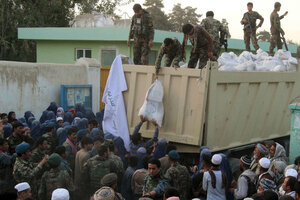Is Obama rethinking his vow to bring troops home from Afghanistan?
A paper signed by more than 20 former top US officials says that US and NATO forces 'should be maintained at or close to present levels.'

Afghan National Army troops distribute aid to the civilians of Kunduz, Afghanistan October 14, 2015. The Taliban said they were pulling back in the northern city of Kunduz on Tuesday in order to protect civilians, but fighting continued elsewhere in the country with government troops battling to reopen the main highway south of the capital Kabul.
Stringer/Reuters
A paper released on Wednesday signed by more than 20 former senior government officials advises President Obama to reconsider his planned withdrawal of troops from Afghanistan. According to The New York Times, unnamed sources from the Pentagon have said that the president is taking their advice seriously.
Published by an international affairs think tank called the Atlantic Council, the paper states that "US and NATO force levels and presence around the country, as well as intelligence assets, should be maintained at or close to present levels."
The paper was principally authored by James B. Cunningham, former ambassador to Afghanistan, who emphasizes the need to keep supporting Afghan forces, as well as allowing the next US president "as much flexibility as possible."
The list of senior officials who added their signatures to the paper include both Democrats and Republicans, among them Madeleine Albright, secretary of state under President Bill Clinton; Stephen Hadley, national security adviser to President George W. Bush; two former defense secretaries, Chuck Hagel and Leon Panetta (who also ran the Central Intelligence Agency); and four former American ambassadors to Afghanistan. The paper is co-sponsored by Senator John McCain (R-Ariz.) and Jack Reed (D-RI).
The "most seriously considered choice", according to officials speaking to the Times, is a proposal made last August by then-Joint Chiefs of Staff chairman Gen. Martin Dempsey "to keep 3,000 to 5,000 troops for the counterterrorism mission."
Obama did not immediately dismiss the idea, marking the first known departure from his repeated promises to end US military presence in a country whose war he declared over at the end of 2014.
A less drastic option, according to Pentagon officials speaking anonymously to the Times, are to maintain a security force of roughly 1,000 troops to primarily protect American diplomats. At the other end of the spectrum is the option – which some say will be the likely one – of keeping the current level of about 9,800 troops.
At a press briefing last week, White House Press Secretary Josh Earnest outlined what he called "essentially two missions" of the military currently in Afghanistan: one to protect national interests, and another to provide "training, advice, and assistance to Afghan security forces."
As for how Obama will decide if that continues, which Mr. Earnest said would happen as soon as the beginning of next year, he said Obama would take into account the recommendations of General John Campbell, who currently leads NATO's mission in Afghanistan, as well as input from diplomats, the CIA, and the Pentagon.
According to the United Nations, insurgents are more spread out in Afghanistan than at any other time since 2001, when the US first invaded the region following 9/11. Officials speaking to the Times said there is still "some debate" about troop levels, which costs $10 billion to $15 billion annually in government defense spending to maintain.

